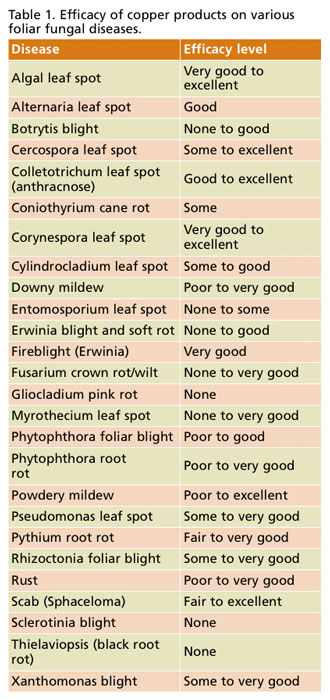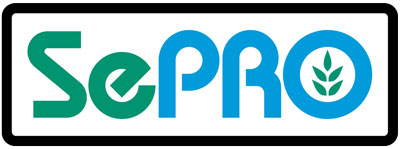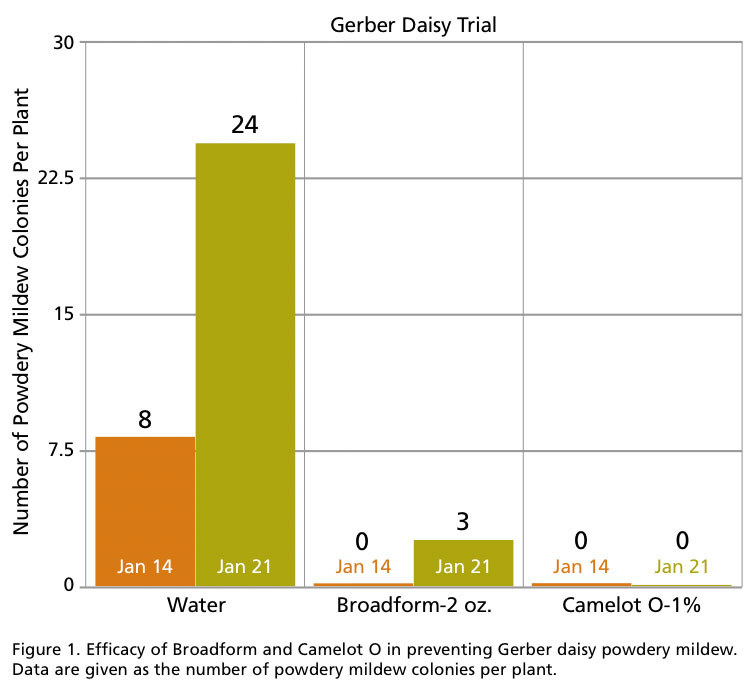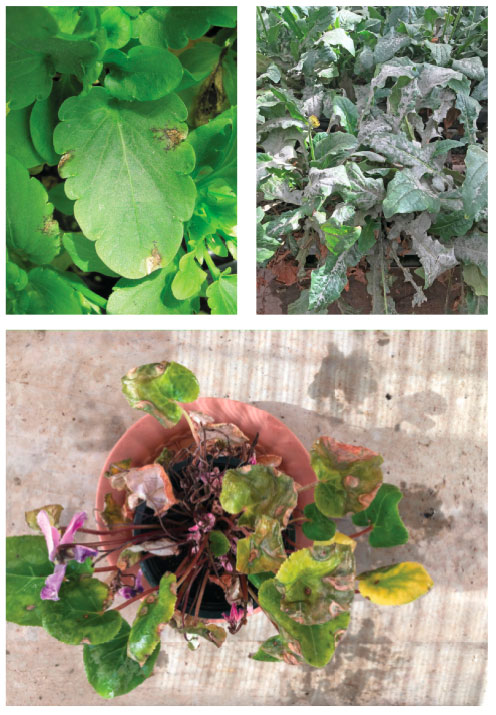2/1/2022
Copper: It’s Not Just for Bacteria
A.R. Chase


Some of the first fungicides developed contained copper. In the 1800s, copper sulfate pentahydrate was formulated with lime into Bordeaux mix. Many other types of coppers followed, including cuprous oxide in 1932. Since then, plant safety became a goal with the development of more effective copper fungicides—copper hydroxide was first used in 1968. Many of the currently available copper fungicides are based on copper hydroxide (CuPRO 5000, Kalmor, Kocide 3000), as well as copper sulfate pentahydrate (Phyton 27), basic copper sulfate (Cuproxat) and copper octanoate (Camelot O, Grotto).
Copper is used in various forms as an algaecide, bactericide, fungicide and in water treatment. In ornamentals, copper is often thought of as a bactericide only, perhaps due to the fact that there are very few effective bactericides in our industry. In nurseries, copper fungicides are widely used on leaf diseases due to their relatively low expense (in some cases) and broad-spectrum activity.
Copper fungicides are classified as multi-site and act by disruption of many cellular proteins, making resistance to them theoretically unlikely to develop. This is difficult to understand, as bacteria become resistant to copper rapidly if it’s the main or only type of product used for disease control. This was noted many times in certain ornamental and vegetable crops since at least the 1960s.
There are many uses for copper fungicides besides bacterial diseases (see Table 1). One thing that’s interesting to note is trial results have been quite variable. For instance, control of downy mildew can be poor to very good depending on the plant, the level of disease when treatments start and the safety of the specific copper to that crop. This may indicate that unless treatments are preventative, they may not be as effective.
Treatment interval can be critical, as well. Copper fungicides are thought to remain on the leaf surface for one to two weeks, depending on rainfall or overhead irrigation. Thus, treatments that are less frequent can be expected to yield lower levels of disease control.
Some of the best targets for copper fungicides (besides bacterial diseases) have been leaf spots (like Alternaria, Cercospora, Colletotrichum and Sphaceloma), powdery mildew and rust. Our research wouldn’t support use of copper fungicides for Botrytis blight. These products can cause minor phytotoxicity during the winter when sprays dry slowly, which sometimes makes Botrytis worse after a copper spray than before one. The closely related Sclerotinia blight hasn’t been controlled by copper products tested in our trials. (Be sure to read labels for use sites and rates.) Most of the drench trials included in the table were conducted on Phyton 27.
One of our most recent trials with a copper product employed Gerbera jamesonii Revolution Orange With Dark Eye and Flor Midi Yellow With Dark Eye. Data in the graph (Figure 1) represent the yellow cultivar, which was more susceptible to the powdery mildew than the orange-flowered ones. Plants were inoculated on November 27, 2020 by placing gerbera daisy plants infected with powdery mildew in the same greenhouse and using an oscillating fan to move conidia of Oidium sp. throughout the trial.
 Treatments were applied with a pump action hand sprayer three times (November 26, and December 10 and 24) to the point of runoff. Disease was rated on January 14, 2021 by counting the number of powdery mildew colonies on each plant. The data showed that Camelot O was as effective as Broadform on both cultivars in preventing this powdery mildew.
Treatments were applied with a pump action hand sprayer three times (November 26, and December 10 and 24) to the point of runoff. Disease was rated on January 14, 2021 by counting the number of powdery mildew colonies on each plant. The data showed that Camelot O was as effective as Broadform on both cultivars in preventing this powdery mildew.
One way to broaden the level of control with copper products might be to use a tank mix or even a premix. Tank-mixing some of the OMRI-listed products like Triathlon BA with an OMRI-listed copper like Camelot O can result in a broader spectrum spray that also helps prevent the possibility of copper-resistance development. This combination has been promoted by organic vegetable producers. It might be especially helpful when fighting bacterial diseases, but clearly copper can be effective on some fungal diseases as well.
Alternatively, you could add a very broad-spectrum fungicide like mancozeb with a copper to aid in deleting copper resistance development to bacteria and many fungi. Junction is one such pre-mix that can control both a range of foliar diseases, as well as assist in delaying resistance.
As we continue to see premixes registered for our industry, it’ll be a good idea to consider making your own, specific to your particular needs. Remember coppers can be key components in a broad-spectrum approach to disease management. GT
 A. R. Chase is a plant pathologist with Chase Agricultural Consulting, LLC. She can be reached at archase@chaseresearch.net.
A. R. Chase is a plant pathologist with Chase Agricultural Consulting, LLC. She can be reached at archase@chaseresearch.net.
Clockwise from top left: Cercospora leaf spot on pansy.
Powdery mildew on gerbera daisy.
Collectotrichum leaf spot (anthracnose on cyclamen).